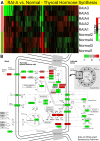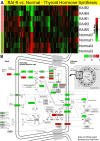Gene Expression Analysis of Papillary Thyroid Carcinoma With Lymph Node Metastasis and Radioiodine Refractivity
- PMID: 40746809
- PMCID: PMC12310417
- DOI: 10.7759/cureus.87001
Gene Expression Analysis of Papillary Thyroid Carcinoma With Lymph Node Metastasis and Radioiodine Refractivity
Abstract
Background/aim: Papillary thyroid carcinoma (PTC) is the most prevalent form of thyroid cancer (TC) and is generally associated with a favorable prognosis. Nevertheless, aggressive variants of PTC that exhibit metastasis and resistance to radioiodine (RAI) therapy present significant clinical challenges. This study sought to generate a preliminary dataset on gene expression in RAI-refractory PTC using microarray analysis.
Materials and methods: Fresh frozen thyroid tissues were collected from PTC patients without lymph node metastasis and RAI avidity (n = 5), PTC patients with lymph node metastasis and RAI refractoriness (n = 5), and adjacent normal thyroid tissues (n = 4). The samples were cryosectioned, stained with hematoxylin and eosin, and confirmed by a pathologist. Nucleic acids were extracted using the AllPrep DNA/RNA/miRNA Universal Kit (Qiagen, Germany), and RNA quantity, purity, and integrity were assessed. RNA samples were amplified, labelled using the Agilent Low Input Quick Amp Labeling Kit (Agilent Technologies, Santa Clara, CA, US), and purified using the RNeasy Mini Kit (Qiagen). Cy3-labelled cRNA was fragmented and hybridized to Agilent SurePrint G3 Human GE v3 8 × 60 K microarray slides. Data were analyzed using AltAnalyze software and the iDEP web application.
Results: Our results revealed distinct expression patterns between RAI-avid and RAI-refractory PTC, with significant downregulation observed in key thyroid hormone synthesis genes, such as TPO, DIO1, and SLC26A4, across both groups. Notably, TG showed a variable expression pattern, suggesting its complex role in PTC pathophysiology. Pathway analysis highlighted the disruption of metabolic and immune-related pathways, emphasizing the altered physiological state of RAI-refractory PTC.
Conclusion: This study provides essential insights into the molecular underpinnings of RAI resistance in PTC and offers a foundation for future research aimed at developing targeted therapies that could enhance treatment efficacy and patient outcomes.
Keywords: cancer biomarker; microarray; papillary thyroid carcinoma; precision medicine; radioiodine; refractory.
Copyright © 2025, Mohamad Pakarulrazy et al.
Conflict of interest statement
Human subjects: Informed consent for treatment and open access publication was obtained or waived by all participants in this study. Universiti Kebangsaan Malaysia Research Ethics Committee issued approval UKM PPI/111/8/JEP-2020-677. Animal subjects: All authors have confirmed that this study did not involve animal subjects or tissue. Conflicts of interest: In compliance with the ICMJE uniform disclosure form, all authors declare the following: Payment/services info: This research was funded by the Fundamental Research Grant Scheme (FRGS) of the Ministry of Higher Education Malaysia (FRGS/1/2019/SKK04/UKM/03/1). Financial relationships: All authors have declared that they have no financial relationships at present or within the previous three years with any organizations that might have an interest in the submitted work. Other relationships: All authors have declared that there are no other relationships or activities that could appear to have influenced the submitted work.
Figures



Similar articles
-
Expression of WNT10A in papillary thyroid carcinoma and its effect on cell proliferation, invasion, and metastasis.Zhong Nan Da Xue Xue Bao Yi Xue Ban. 2025 Mar 28;50(3):402-415. doi: 10.11817/j.issn.1672-7347.2025.240237. Zhong Nan Da Xue Xue Bao Yi Xue Ban. 2025. PMID: 40628509 Chinese, English.
-
Comparison of total thyroidectomy and lobectomy for intermediate-risk papillary thyroid carcinoma with lateral lymph node metastasis: a systematic review and meta-analysis.Int J Surg. 2025 Jun 25. doi: 10.1097/JS9.0000000000002673. Online ahead of print. Int J Surg. 2025. PMID: 40557546
-
Multicenter analysis of radioactive iodine therapy outcomes after total thyroidectomy for T1-T2 stage papillary thyroid carcinoma with cervical lymph node metastasis in China.Int J Surg. 2025 Jun 30. doi: 10.1097/JS9.0000000000002838. Online ahead of print. Int J Surg. 2025. PMID: 40576429
-
BRAF mutation in papillary thyroid cancer and its value in tailoring initial treatment: a systematic review and meta-analysis.Medicine (Baltimore). 2012 Sep;91(5):274-286. doi: 10.1097/MD.0b013e31826a9c71. Medicine (Baltimore). 2012. PMID: 22932786
-
Papillary thyroid carcinoma with exuberant nodular fasciitis-like stroma: treatment outcome and prognosis.J Laryngol Otol. 2006 Apr;120(4):338-42. doi: 10.1017/S0022215106000211. J Laryngol Otol. 2006. PMID: 16623982
References
LinkOut - more resources
Full Text Sources
Miscellaneous
